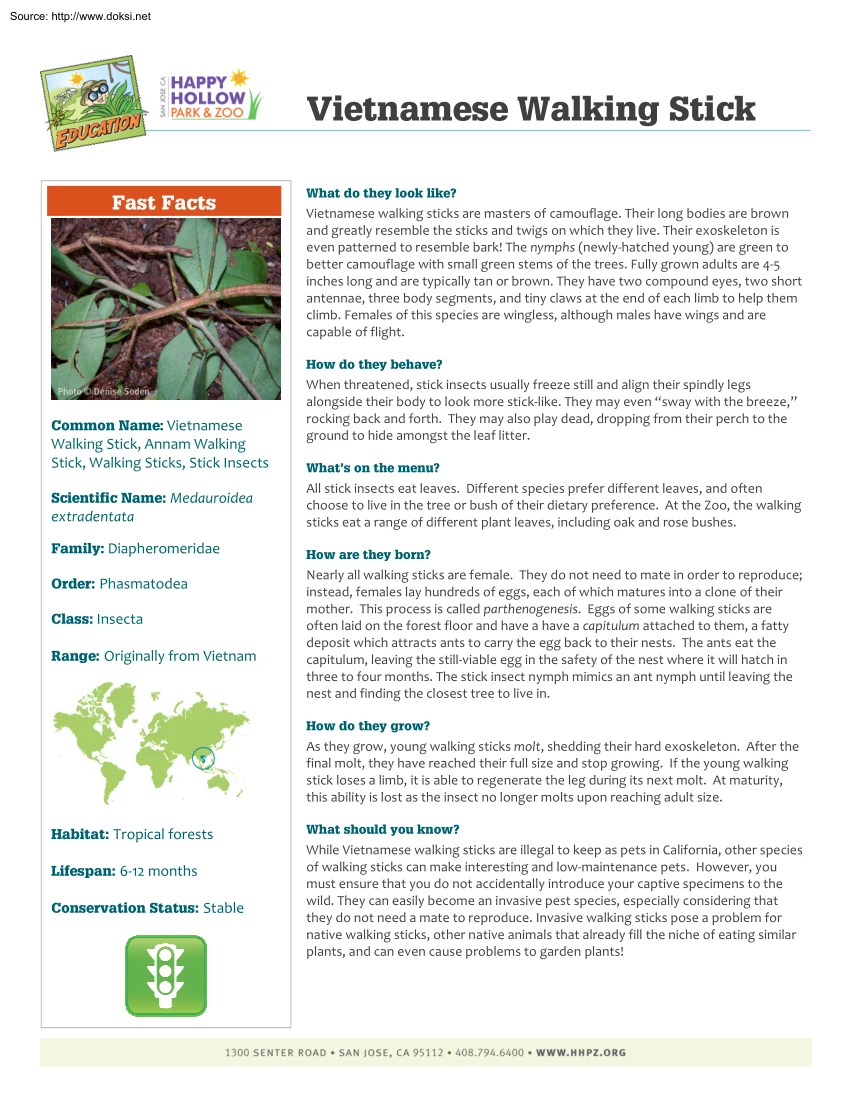Please log in to read this in our online viewer!

Please log in to read this in our online viewer!
No comments yet. You can be the first!
What did others read after this?
Content extract
Source: http://www.doksinet Vietnamese Walking Stick Fast Facts What do they look like? Vietnamese walking sticks are masters of camouflage. Their long bodies are brown and greatly resemble the sticks and twigs on which they live. Their exoskeleton is even patterned to resemble bark! The nymphs (newly-hatched young) are green to better camouflage with small green stems of the trees. Fully grown adults are 4-5 inches long and are typically tan or brown. They have two compound eyes, two short antennae, three body segments, and tiny claws at the end of each limb to help them climb. Females of this species are wingless, although males have wings and are capable of flight. How do they behave? Common Name: Vietnamese Walking Stick, Annam Walking Stick, Walking Sticks, Stick Insects When threatened, stick insects usually freeze still and align their spindly legs alongside their body to look more stick-like. They may even “sway with the breeze,” rocking back and forth. They may also
play dead, dropping from their perch to the ground to hide amongst the leaf litter. What’s on the menu? extradentata All stick insects eat leaves. Different species prefer different leaves, and often choose to live in the tree or bush of their dietary preference. At the Zoo, the walking sticks eat a range of different plant leaves, including oak and rose bushes. Family: Diapheromeridae How are they born? Scientific Name: Medauroidea Order: Phasmatodea Class: Insecta Range: Originally from Vietnam Nearly all walking sticks are female. They do not need to mate in order to reproduce; instead, females lay hundreds of eggs, each of which matures into a clone of their mother. This process is called parthenogenesis Eggs of some walking sticks are often laid on the forest floor and have a have a capitulum attached to them, a fatty deposit which attracts ants to carry the egg back to their nests. The ants eat the capitulum, leaving the still-viable egg in the safety of the nest where
it will hatch in three to four months. The stick insect nymph mimics an ant nymph until leaving the nest and finding the closest tree to live in. How do they grow? As they grow, young walking sticks molt, shedding their hard exoskeleton. After the final molt, they have reached their full size and stop growing. If the young walking stick loses a limb, it is able to regenerate the leg during its next molt. At maturity, this ability is lost as the insect no longer molts upon reaching adult size. Habitat: Tropical forests Lifespan: 6-12 months Conservation Status: Stable What should you know? While Vietnamese walking sticks are illegal to keep as pets in California, other species of walking sticks can make interesting and low-maintenance pets. However, you must ensure that you do not accidentally introduce your captive specimens to the wild. They can easily become an invasive pest species, especially considering that they do not need a mate to reproduce. Invasive walking sticks pose a
problem for native walking sticks, other native animals that already fill the niche of eating similar plants, and can even cause problems to garden plants!
play dead, dropping from their perch to the ground to hide amongst the leaf litter. What’s on the menu? extradentata All stick insects eat leaves. Different species prefer different leaves, and often choose to live in the tree or bush of their dietary preference. At the Zoo, the walking sticks eat a range of different plant leaves, including oak and rose bushes. Family: Diapheromeridae How are they born? Scientific Name: Medauroidea Order: Phasmatodea Class: Insecta Range: Originally from Vietnam Nearly all walking sticks are female. They do not need to mate in order to reproduce; instead, females lay hundreds of eggs, each of which matures into a clone of their mother. This process is called parthenogenesis Eggs of some walking sticks are often laid on the forest floor and have a have a capitulum attached to them, a fatty deposit which attracts ants to carry the egg back to their nests. The ants eat the capitulum, leaving the still-viable egg in the safety of the nest where
it will hatch in three to four months. The stick insect nymph mimics an ant nymph until leaving the nest and finding the closest tree to live in. How do they grow? As they grow, young walking sticks molt, shedding their hard exoskeleton. After the final molt, they have reached their full size and stop growing. If the young walking stick loses a limb, it is able to regenerate the leg during its next molt. At maturity, this ability is lost as the insect no longer molts upon reaching adult size. Habitat: Tropical forests Lifespan: 6-12 months Conservation Status: Stable What should you know? While Vietnamese walking sticks are illegal to keep as pets in California, other species of walking sticks can make interesting and low-maintenance pets. However, you must ensure that you do not accidentally introduce your captive specimens to the wild. They can easily become an invasive pest species, especially considering that they do not need a mate to reproduce. Invasive walking sticks pose a
problem for native walking sticks, other native animals that already fill the niche of eating similar plants, and can even cause problems to garden plants!




 When reading, most of us just let a story wash over us, getting lost in the world of the book rather than paying attention to the individual elements of the plot or writing. However, in English class, our teachers ask us to look at the mechanics of the writing.
When reading, most of us just let a story wash over us, getting lost in the world of the book rather than paying attention to the individual elements of the plot or writing. However, in English class, our teachers ask us to look at the mechanics of the writing.